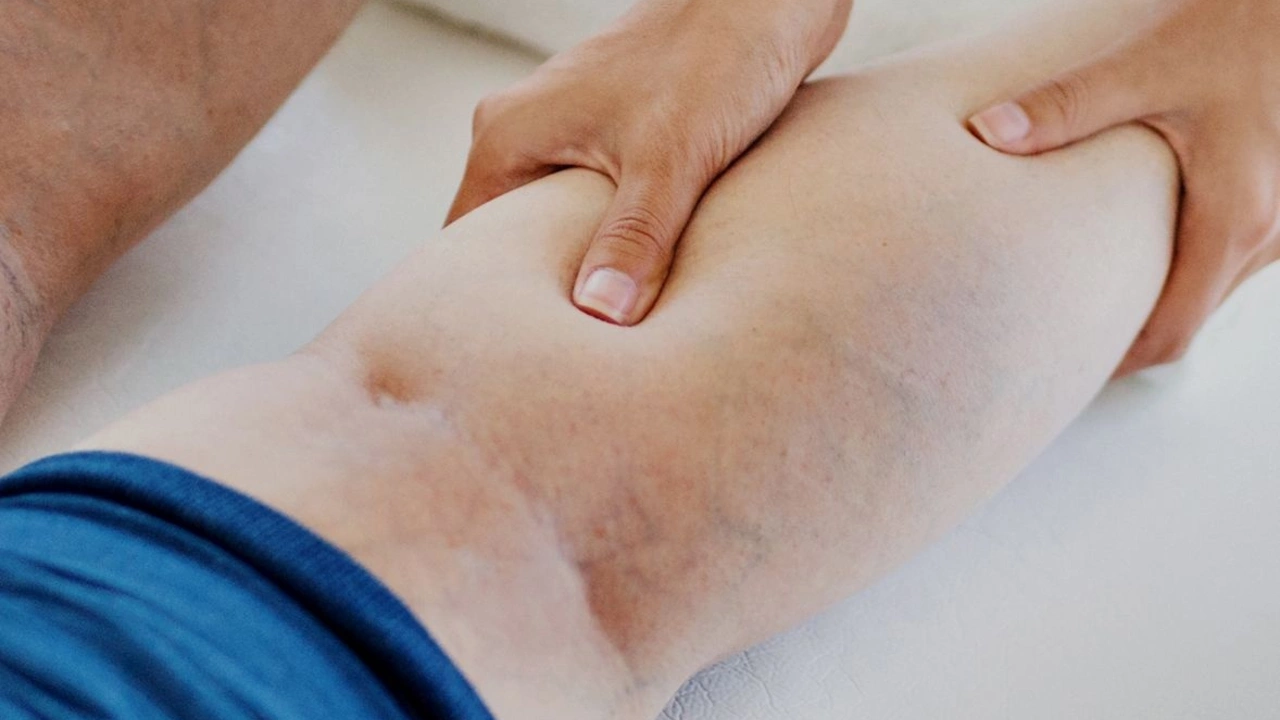The Connection Between DVT and Chronic Venous Insufficiency

Understanding DVT and Chronic Venous Insufficiency
Before we delve into the connection between Deep Vein Thrombosis (DVT) and Chronic Venous Insufficiency (CVI), it's important to understand what these two conditions are. DVT is a condition that occurs when a blood clot forms in one or more of the deep veins in your body, usually in your legs. CVI, on the other hand, is a long-term condition where the veins in the legs do not efficiently return blood back to the heart.
Causes and Symptoms of DVT
DVT is often caused by conditions that affect how your blood clots. It can also occur if you don't move for a long time, such as after surgery or an accident, or when you're confined to bed. Symptoms of DVT can include swelling, pain, warmth, and redness in the affected area, but sometimes there may be no symptoms at all.
Causes and Symptoms of Chronic Venous Insufficiency
Chronic Venous Insufficiency occurs when your leg veins don't allow blood to flow back to your heart. This can happen because the valves in the veins are damaged or the veins are weak. Symptoms can include swelling in the legs and ankles, aching or tiredness in the legs, varicose veins, skin changes, and ulcers on the legs.
How DVT leads to Chronic Venous Insufficiency
Now that we have a basic understanding of both conditions, let's explore the connection between DVT and CVI. When a blood clot forms in the deep veins of the body, it can damage the veins and their valves. This makes it difficult for the veins to pump blood back to the heart, leading to the symptoms of CVI. Therefore, having DVT can increase your risk of developing Chronic Venous Insufficiency.
Diagnosing DVT and CVI
Diagnosis of both DVT and CVI involves a physical exam and a review of your medical history. Your doctor may also use ultrasound or other imaging tests to look for blood clots or check the condition of your veins. Early diagnosis of these conditions is crucial for preventing serious complications.
Treatment Options for DVT
For DVT, treatment typically involves medications to prevent blood clots from getting bigger, stop new clots from forming, and prevent clots from breaking off and traveling to your lungs. In severe cases, surgery might be required. It's also important to make lifestyle changes, such as regular exercise and wearing compression stockings, to prevent DVT from recurring.
Treatment Options for Chronic Venous Insufficiency
For CVI, treatment usually includes changes in lifestyle, such as elevating the legs, wearing compression stockings, and exercising regularly. In some cases, medication or surgery may be necessary. The goal of treatment is to improve blood flow in the leg veins and to prevent or manage symptoms.
Preventing DVT and Chronic Venous Insufficiency
Prevention is always better than cure. Both DVT and CVI can be prevented with regular exercise, maintaining a healthy weight, not smoking, and taking breaks to move around if you're travelling or sitting for long periods. In some cases, if you're at high risk, your doctor may recommend medication to prevent DVT and CVI.






marcel lux
July 1, 2023 AT 20:10Thanks for sharing this overview. It’s useful to see how a clot can damage venous valves and set the stage for chronic insufficiency. Regular movement and compression stockings remain key preventive steps.
Charlotte Shurley
July 1, 2023 AT 20:27Very clear summary.
Steph Hooton
July 1, 2023 AT 20:43I appreciate the thoroughness of this post, especially the way it ties the pathophysiology of DVT to later venous insufficiency. When a clot lodges in a deep vein, it can cause endothelial injury, which in turn can trigger inflammation around the valve leaflets. This inflammation may lead to fibrosis and stiffening of the valve cusps, impairing their ability to close properly. Impaired closure allows blood to reflux during ambulation, creating venous hypertension. Over time, that increased pressure can dilate superficial veins, producing the classic varicosities we see clinically. Moreover, the stagnant blood behind a residual thrombus can serve as a nidus for further clot propagation, perpetuating the cycle. Early detection through duplex ultrasound can identify subclinical valve damage before symptomatic swelling appears. Compression therapy not only mitigates edema but also promotes venous return, reducing the mechanical stress on compromised valves. Lifestyle interventions, such as weight management and avoiding prolonged immobility, are essential adjuncts to pharmacologic prophylaxis. In patients with a history of DVT, periodic follow‑up with a vascular specialist can catch early signs of CVI, allowing for timely endovenous ablation or sclerotherapy if needed. Finally, patient education about leg elevation and gentle calf‑pump exercises can empower individuals to take charge of their own venous health.
Judson Voss
July 1, 2023 AT 21:00While the article is decent, it glosses over the fact that many patients never develop CVI after a DVT, so the risk‑factor link isn’t as deterministic as implied.
Jessica Di Giannantonio
July 1, 2023 AT 21:17The connection is indeed real, but I think the piece could have highlighted how aggressive early mobilization after surgery dramatically cuts down the DVT‑to‑CVI cascade.
RUCHIKA SHAH
July 1, 2023 AT 21:33DVT and CVI are linked. Prevent with movement and healthy weight.
Justin Channell
July 1, 2023 AT 21:50Great info! 👍 Keep those legs moving and consider compression if you’re at risk.
Basu Dev
July 1, 2023 AT 22:07From a clinical perspective, it is essential to recognize that the sequelae of deep vein thrombosis extend beyond the acute phase. The thrombotic obstruction can cause a cascade of endothelial damage, which in turn leads to fibrosis and loss of valve competence. When the valves fail to close properly, venous reflux occurs, raising hydrostatic pressure in the capillary beds of the lower extremities. This pressure elevation is a primary driver of the edema, skin changes, and ulcerations observed in chronic venous insufficiency. Moreover, the presence of residual clot material can serve as a scaffold for further thrombogenesis, creating a vicious cycle that worsens both conditions. Early duplex scanning provides valuable information about residual thrombus burden and valve function, allowing clinicians to stratify patients for more aggressive interventions such as catheter‑directed thrombolysis or pharmacomechanical thrombectomy. In addition, long‑term anticoagulation, while necessary for many patients, must be balanced against bleeding risk, especially when considering adjunctive procedures like endovenous laser therapy for varicose veins. Lifestyle modifications-regular calf‑pump exercises, weight control, smoking cessation-should be emphasized as part of a comprehensive management plan. Patient adherence to compression therapy markedly improves outcomes, reducing the incidence of post‑thrombotic syndrome, which is essentially the clinical manifestation of chronic venous insufficiency after DVT. Finally, multidisciplinary follow‑up, involving primary care, vascular surgery, and physical therapy, ensures that any early signs of venous deterioration are caught and treated promptly, preserving limb function and quality of life.
Krysta Howard
July 1, 2023 AT 22:23Okay, good overview, but don’t forget that not everyone tolerates compression stockings-some patients actually develop skin breakdown, so alternatives must be discussed.
Elizabeth Post
July 1, 2023 AT 22:40Solid recap-definitely useful for patients newly diagnosed with a clot.
Brandon Phipps
July 1, 2023 AT 22:57Interesting read. In practice I’ve seen that patients who keep a leg‑elevating routine at night report less swelling. Also, compliance with compression is higher when the stockings are custom‑fit rather than off‑the‑shelf.
yogesh Bhati
July 1, 2023 AT 23:13Hmm interesting but i think you missing the role of genetics i mean some people just have weak veins from birth so they get CVI even without a DVT
Akinde Tope Henry
July 1, 2023 AT 23:30Everyone should read this and start moving – it’s simple.
Brian Latham
July 1, 2023 AT 23:47Meh, could have been shorter.
Barbara Todd
July 2, 2023 AT 00:03I wonder why the article didn’t mention newer oral anticoagulants that lower recurrence risk.
nica torres
July 2, 2023 AT 00:20Loved the practical tips! Keep those legs up and stay active-your future self will thank you.
Dean Marrinan
July 2, 2023 AT 00:37Nice rundown! 😎 Just remember, if you’re stuck on a long flight, stand up, stretch, and do some ankle circles. Your veins will thank you.
Oluseyi Anani
July 2, 2023 AT 00:53All that’s said is accurate, but I’d add that patients with a prior DVT should be screened for hidden reflux using duplex ultrasonography even if they feel fine.
Jeremy Wolfe
July 2, 2023 AT 01:10Great guide-especially the part about combining compression with leg elevation. That combo really cuts down swelling.
Rahul yadav
July 2, 2023 AT 01:27Really helpful! 🌟 For anyone dealing with post‑clot leg pain, gentle calf pumps every few hours can make a world of difference. Keep moving and stay cozy.